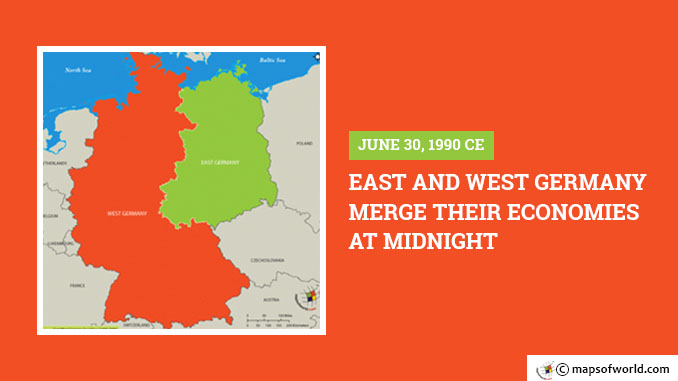Though the Berlin Wall had come down seven months before, the official work of joining the East Germans to their brothers and sisters in the West had not been accomplished as summer set in over central Europe. Having been occupied since the end of World War II in 1945, the unification of the two economies on June 30, 1990 was a major step toward self-government for the German people. The process began in late November of 1989, when West German Chancellor Helmut Kohl presented a Ten-Point Plan for reunification less than three weeks after the Berlin Wall was opened up in front of an international television audience. Within days, the Communist leadership in East Germany stepped down, opening the door to the rise of competing parties for the elections Kohl had proposed. Despite initial plans for voting to take place in May, the interim East German government – quickly being emptied as citizens poured across the border – moved the elections forward to March 18th. The winners, running on a platform of ensuring a lasting connection with the former West Germany, soon captured most of the seats available at the federal, state and local levels. The process would be tricky, though, as Kohl insisted a unified Germany should be a part of NATO while his Eastern counterparts initially proposed an agreement on neutrality, much like their Swiss neighbors. As the process began, the economic aspects of molding the two countries into one new nation would end up being among the simplest steps. Effective on July 1st, the Deutsche Mark became the official currency throughout the sixteen states in the Federal Republic of Germany. East and West Germany no longer existed as separate entities, but there was still a large amount of geopolitical wrangling to be done. After World War II, the nation had been divided among the USA, British, French and Soviets. With reunification, leaders from these four nations joined with the heads of the two German governments in a series of “Two-plus-Four” negotiations. In five meetings over the course of seven months, the question of Germany’s involvement in NATO would be the primary sticking point. During the July summit in Paris, Kohl and Soviet President Mikhail Gorbachev announced a compromise had been reached. Two months later, all six leaders signed the Treaty on the Final Settlement With Respect to Germany, ending the Four Powers agreement from 1945 and setting up the withdrawal of Soviet, British, French and American troops ending in 1994. On October 3, 1990, the final hurdle to a political unification was cleared: the five German states that had been frozen behind the Berlin Wall during the Cold War were now part of the Bundesrepublik Deutschland, with Bonn remaining a provisional capital until the government could be permanently moved to Berlin. Nearly two months to the day, Germans took to the polls for the first national elections since 1933.
June 30, 1990 CE – East and West Germany Merge Their Economies at Midnight
Though the Berlin Wall had come down seven months before, the official work of joining the East Germans to their brothers and sisters in the West had not been accomplished…
